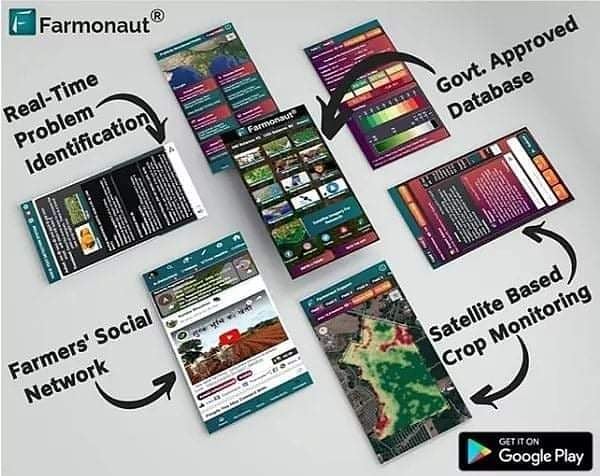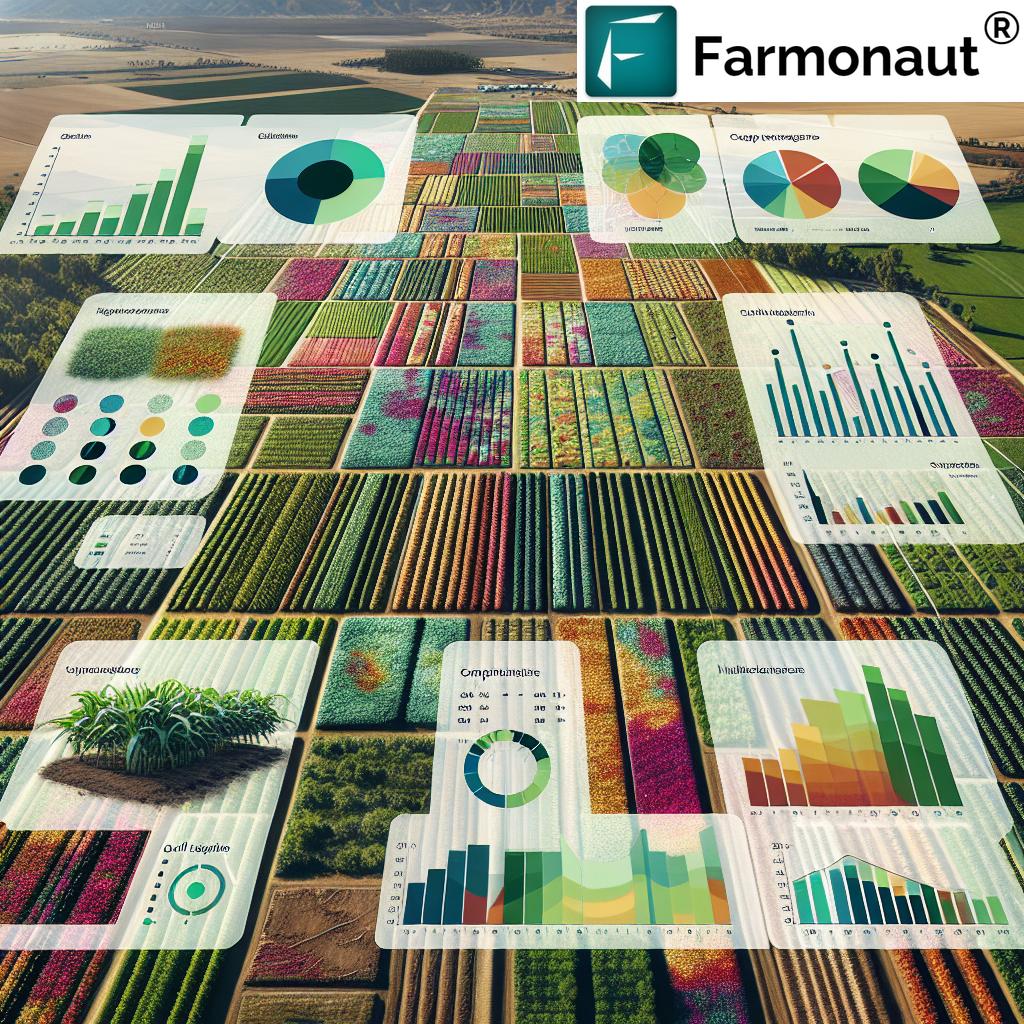Identifying and Controlling Zinc Deficiency: Symptoms, Effects on Plant Growth, and Micronutrient Solutions

In the world of agriculture, understanding and managing plant nutrition is crucial for optimal crop production. Among the various essential nutrients, zinc plays a vital role in plant growth and development. However, zinc deficiency is a common problem that can significantly impact crop yields and quality. In this comprehensive guide, we’ll explore the symptoms, effects, and solutions for zinc deficiency in plants, as well as how advanced technologies like Farmonaut’s satellite-based monitoring can help farmers identify and address this issue efficiently.
Understanding Zinc’s Role in Plant Growth
Zinc is a crucial micronutrient that plays several essential roles in plant physiology:
- Enzyme activation: Zinc is a component of many enzymes involved in various metabolic processes.
- Protein synthesis: It’s essential for the production of proteins and growth regulators.
- Chlorophyll formation: Zinc contributes to the production of chlorophyll, vital for photosynthesis.
- Carbohydrate metabolism: It aids in the conversion of starches to sugars.
- Pollen formation: Zinc is crucial for the development of pollen, affecting plant reproduction.
Given these critical functions, a zinc deficiency can have far-reaching consequences on plant growth and productivity.
Recognizing Zinc Deficiency Symptoms
Identifying zinc deficiency early is key to preventing significant crop losses. Here are the primary symptoms to watch for:
- Chlorosis: Yellowing between the veins of leaves, particularly in younger leaves.
- Stunted growth: Plants may appear smaller with shortened internodes.
- Leaf deformities: Leaves may be small, narrow, or have a “rosette” appearance.
- Necrotic spots: Brown spots may appear on older leaves.
- Bronzing: A bronze or purple tint may develop on leaves, especially in corn.

It’s important to note that these symptoms can vary depending on the crop type and severity of the deficiency. Let’s take a closer look at how zinc deficiency manifests in different crops:
Zinc Deficiency in Cereal Crops
In cereals like wheat, rice, and corn, zinc deficiency often appears as:
- Interveinal chlorosis in younger leaves
- Brown spots on older leaves
- Stunted growth and reduced tillering
- Delayed maturity
Zinc Deficiency in Fruit Trees
Fruit trees suffering from zinc deficiency may exhibit:
- “Little leaf” syndrome – small, narrow leaves
- Rosetting of terminal leaves
- Reduced fruit set and size
- Twig dieback in severe cases
Zinc Deficiency in Vegetable Crops
Vegetables like tomatoes, beans, and onions may show:
- Interveinal chlorosis
- Stunted growth and reduced leaf size
- Distorted leaf shape
- Reduced flowering and fruit set
Factors Contributing to Zinc Deficiency
Understanding the causes of zinc deficiency is crucial for effective management. Several factors can contribute to this nutrient imbalance:
- Soil pH: High pH soils (alkaline) can reduce zinc availability.
- Soil organic matter: Low organic matter can decrease zinc retention in soil.
- Soil texture: Sandy soils are more prone to zinc leaching.
- High phosphorus levels: Excessive phosphorus can interfere with zinc uptake.
- Cold, wet soils: These conditions can reduce zinc availability and root growth.
- Intensive cropping: Continuous cultivation without proper nutrient management can deplete zinc.
The Impact of Zinc Deficiency on Plant Growth and Yield
Zinc deficiency can have significant negative impacts on crop production:
- Reduced photosynthesis due to chlorophyll deficiency
- Stunted growth and reduced biomass production
- Delayed maturity and uneven crop ripening
- Decreased pollen viability and reduced seed set
- Increased susceptibility to diseases and environmental stresses
- Significant yield reductions, often 20-30% in severe cases
These impacts underscore the importance of timely detection and correction of zinc deficiency to maintain optimal crop productivity.
Detecting Zinc Deficiency with Advanced Technology
While visual symptoms are helpful, they often appear when the deficiency has already significantly impacted plant growth. This is where advanced technologies like satellite-based monitoring come into play. At Farmonaut, we leverage cutting-edge satellite imagery and AI to provide early detection of nutrient deficiencies, including zinc.
Our satellite-based crop health monitoring system can detect subtle changes in plant vigor and chlorophyll content, often before visible symptoms appear. This allows farmers to take proactive measures to address zinc deficiency before it severely impacts crop yield.
To learn more about how Farmonaut’s technology can help you monitor your crops for nutrient deficiencies, visit our app page or explore our API services.
Comparison: Zinc Deficient vs. Healthy Plants
| Characteristic | Zinc Deficient Plants | Healthy Plants | Farmonaut’s Detection Capability |
|---|---|---|---|
| Leaf Color | Interveinal chlorosis, yellowing | Uniform green color | Early detection of color changes through multispectral imaging |
| Growth Patterns | Stunted growth, shortened internodes | Normal, vigorous growth | Identification of growth anomalies through time-series analysis |
| Yield Impact | Reduced yield, smaller fruits/grains | Optimal yield | Predictive yield analysis based on vegetation indices |
Farmonaut’s satellite imagery can detect these symptoms early and at a large scale, enabling proactive management of zinc deficiency across entire fields or regions.
Controlling Zinc Deficiency
Once zinc deficiency is identified, there are several strategies for addressing it:
1. Soil Application
Applying zinc to the soil is a common method for addressing deficiency:
- Zinc sulfate (sulfato de zinc): The most common form, easily soluble in water.
- Zinc oxide: Less soluble but longer-lasting in the soil.
- Zinc chelates: Highly effective in high pH soils.
Application rates typically range from 5-20 kg/ha, depending on soil conditions and crop requirements.
2. Foliar Application
Foliar sprays can provide a quick response, especially for severe deficiencies:
- Zinc sulfate solution (0.5-1%)
- Chelated zinc products
Foliar applications are particularly effective during critical growth stages or when soil conditions limit root uptake.
3. Seed Treatment
Coating seeds with zinc can provide early-season protection against deficiency:
- Zinc oxide or zinc sulfate coating
- Particularly effective for cereals and legumes
4. Zinc-Enriched Fertilizers
Using fertilizers that include zinc can help prevent deficiency:
- NPK fertilizers with added zinc
- Zinc-enriched urea
5. Soil Management Practices
Long-term strategies to improve zinc availability include:
- pH management: Maintaining soil pH between 6.0-7.0 for optimal zinc availability
- Organic matter addition: Increasing soil organic matter to improve zinc retention
- Crop rotation: Including zinc-efficient crops in the rotation
- Reduced tillage: Minimizing soil disturbance to prevent zinc leaching
Balancing Zinc with Other Nutrients
It’s crucial to maintain a balance between zinc and other nutrients, particularly phosphorus and iron. Excessive phosphorus can induce zinc deficiency, while high levels of iron can compete with zinc for uptake. Regular soil testing and balanced fertilization practices are essential for maintaining optimal nutrient levels.
The Role of Technology in Zinc Deficiency Management
Advanced agricultural technologies play a crucial role in efficient zinc deficiency management. At Farmonaut, we offer several tools to help farmers identify and address nutrient deficiencies:
- Satellite-based crop health monitoring: Our platform uses multispectral satellite imagery to detect early signs of nutrient stress, including zinc deficiency.
- AI-powered advisory system: Our Jeevn AI system provides personalized recommendations for addressing nutrient deficiencies based on crop type, growth stage, and local conditions.
- Precision application maps: We generate variable-rate application maps for precise and efficient zinc application.
To explore how Farmonaut’s technology can help you manage zinc deficiency and other crop health issues, download our app for Android or iOS.
Case Studies: Successful Zinc Deficiency Management
While we can’t share specific case studies, numerous research studies and field trials have demonstrated the effectiveness of proper zinc management:
- In wheat production, zinc application has been shown to increase yields by 10-15% in deficient soils.
- Rice farmers in Asia have reported yield increases of up to 20% with proper zinc fertilization.
- Corn growers using precision agriculture techniques for zinc application have seen improved uniformity in crop growth and maturity.
The Economic Impact of Zinc Deficiency
Zinc deficiency can have significant economic implications for farmers:
- Reduced crop yields leading to lower income
- Decreased crop quality affecting market value
- Increased susceptibility to diseases and pests, potentially leading to higher management costs
Investing in proper zinc management can provide substantial returns through improved yields and crop quality.
Future Perspectives in Zinc Deficiency Management
As agriculture continues to evolve, several promising developments are on the horizon for zinc deficiency management:
- Biofortification: Development of crop varieties with enhanced zinc uptake and accumulation capabilities.
- Nanotechnology: Use of zinc nanoparticles for more efficient nutrient delivery.
- Precision agriculture: Integration of real-time soil and plant sensors with variable-rate application technologies.
- Machine learning models: Advanced prediction of zinc deficiency risks based on environmental and management factors.
At Farmonaut, we’re continually working to integrate these emerging technologies into our platform to provide farmers with the most advanced tools for nutrient management.
Frequently Asked Questions (FAQ)
1. How quickly can zinc deficiency symptoms appear?
Zinc deficiency symptoms can appear within 2-3 weeks after planting in severe cases, but mild deficiencies may not show visible symptoms until later in the growing season.
2. Can zinc deficiency be confused with other nutrient deficiencies?
Yes, zinc deficiency symptoms can be similar to iron or manganese deficiencies. Soil and tissue testing, along with advanced imaging techniques like those used by Farmonaut, can help accurately diagnose the specific deficiency.
3. How often should I apply zinc to my crops?
The frequency of zinc application depends on soil type, crop requirements, and management practices. In many cases, a single application every 2-3 years is sufficient, but annual applications may be necessary for high-demand crops or very deficient soils.
4. Can I apply too much zinc?
While zinc toxicity is rare, excessive application can interfere with the uptake of other nutrients, particularly iron. It’s important to follow recommended application rates based on soil tests and crop requirements.
5. How does Farmonaut’s technology detect zinc deficiency?
Our satellite-based monitoring system uses multispectral imagery to detect changes in plant vigor and chlorophyll content, which can indicate zinc deficiency. This is combined with AI analysis of historical data and local conditions to provide accurate deficiency predictions.
Conclusion
Zinc deficiency is a significant challenge in modern agriculture, but with proper understanding and management, it can be effectively addressed. By recognizing the symptoms, understanding the causes, and implementing appropriate control measures, farmers can ensure optimal zinc nutrition for their crops, leading to improved yields and quality.
At Farmonaut, we’re committed to providing farmers with the tools and insights needed to manage zinc deficiency and other nutrient issues effectively. Our advanced satellite-based monitoring and AI-powered advisory systems offer a comprehensive solution for proactive nutrient management.
To learn more about how Farmonaut can help you optimize your crop nutrition and overall farm management, visit our website or explore our API documentation at Farmonaut API Docs.
Ready to take your farm management to the next level? Subscribe to Farmonaut today:
By leveraging advanced technology and agronomic expertise, we can work together to ensure healthy, productive crops and sustainable agricultural practices for the future.













